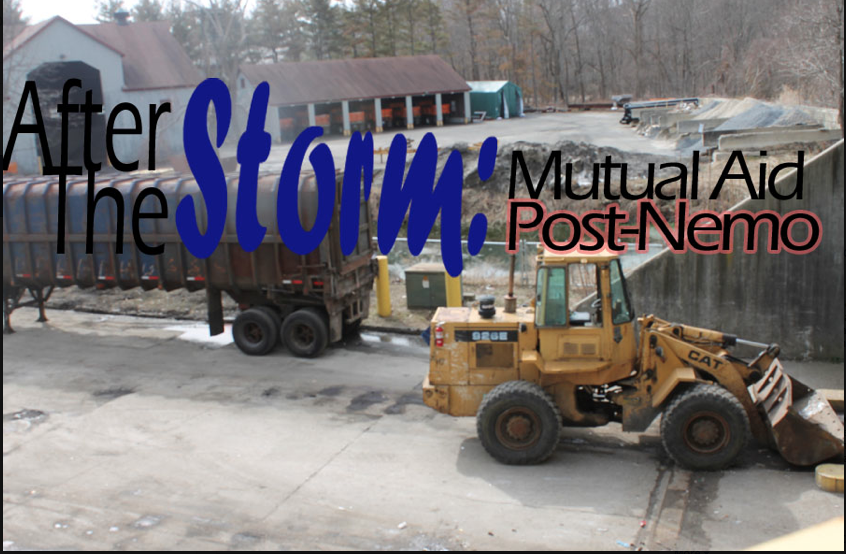“It’s what we refer to as a ‘piece of cake,’” said Westport’s Director of Public Works Steve Edwards, classifying the snowstorm Nemo as a weather event involving only snow, not wind. But although the Feb. 9 storm didn’t wield gusts of wind, the heavy snow accumulation left certain towns less equipped than others and required communication and aid between towns. The system of mutual aid applies to everything from fire staff to highway equipment to pay loaders used for snow clearance.
“If we can, we try to help out our neighbors,” Edwards said.
However, in this storm, Westport did not lend out equipment or services to other towns.
Some areas, especially Bridgeport, had a need for backup. Nemo, an unequal punisher, varied in severity by town, coating Newtown with 17 inches of snow, Westport with 24.5 inches, and dumping Bridgeport with 30 inches and Fairfield with 35, according to National Weather Service Public Data.
“There was a stark difference between the two cities (Bridgeport and Westport),” said Yousef Shahin ’14, a resident of Bridgeport.
“The city looked post apocalyptic,” said Lamont Johnson ’14, a resident of Bridgeport. “Everyone was walking in the street, headed to super markets and gas stations. The few people that did drive were stuck within minutes.”
Bridgeport Public Facilities Director Charles Carroll pointed out the challenges of a more urban environment. “The inner city is much more difficult than rural areas,” Carroll said. “There’s no off street parking and narrower roads.” Carroll also emphasized the necessity to keep routes to Bridgeport’s two hospitals clear, a priority that left many smaller streets neglected.
According to a CT Post article, Bridgeport city officials received criticism from residents for its handling of the storm. Bridgeport’s Mayor did not declare a snow emergency until 5 p.m. on Feb 8, later than neighboring Stamford’s declaration on Feb. 7. Snowbound vehicles blocked plows and city plow drivers were stuck at home, ensconced by the accumulation. During the height of the storm, Bridgeport Mayor Bill Finch called plow drivers off the roads although other towns plowed through the night.
The city put out a request for heavy loader trucks through a regional Emergency Preparedness coordinator, who organizes requests for equipment or services by region. Towns in need contact the coordinator, who forwards the request to other towns in the region. Bridgeport is included in Region 1, an area that includes Fairfield County and Westport.
Westport’s plows had run through the night, keeping streets manageable. Town employees worked from 7 am on Feb 9 through 2 am on Feb 11. This round the clock coverage prevented an accumulation of heavy snow.
However, despite Westport’s prior preparation for the storm, the town didn’t have sufficient equipment to deploy to Bridgeport, which was in need of large loader trucks. According to Edwards, Westport only has two loaders, one of which is in repair and the other being used within Westport. “We just didn’t have the equipment,” Edwards said. “Smaller trucks were essentially useless. Rather than blow out engines, we needed to use loaders and backhoes.”
Monroe, also in Region One, did not provide equipment to Bridgeport either. “We had to plow ourselves out,” said Monroe Deputy Director of Public Works Chris Nowacki. “Everyone was concentrating on their own community at that point.”
However, Bridgeport did receive equipment from Redding and Greenwich, as well as aid from the National Guard.
Other towns also exchanged support. Newtown, a town within Region Five, sent crews to Waterbury through the aid system, according to Frederick Hurley, Newtown Director of Public Works. The town cleared its own streets within 13 hours. Newtown also has 30 pieces of equipment for clearing roads, including six heavy loader trucks, assets that contributed to their ability to help other towns. “Our equipment is heavier duty than most,” Hurley said.
The exchange of supplies and manpower goes beyond snow events. “Mutual aid goes on all the time with fire and police,” Hurley said.
Westport and Fairfield police, both in Region One, work together. According to Edwards, the Region One towns also exchange supplies like highway barricades.
The system organizes towns to respond only to requests within their regions. But during the Sandy Hook shooting in December, Monroe sent fire fighters to stand by at the Sandy Hook Fire Station, even though the towns are in separate districts, one and five respectively. In this state of emergency, where one specific town was in need, support superseded strict region delineations.














































